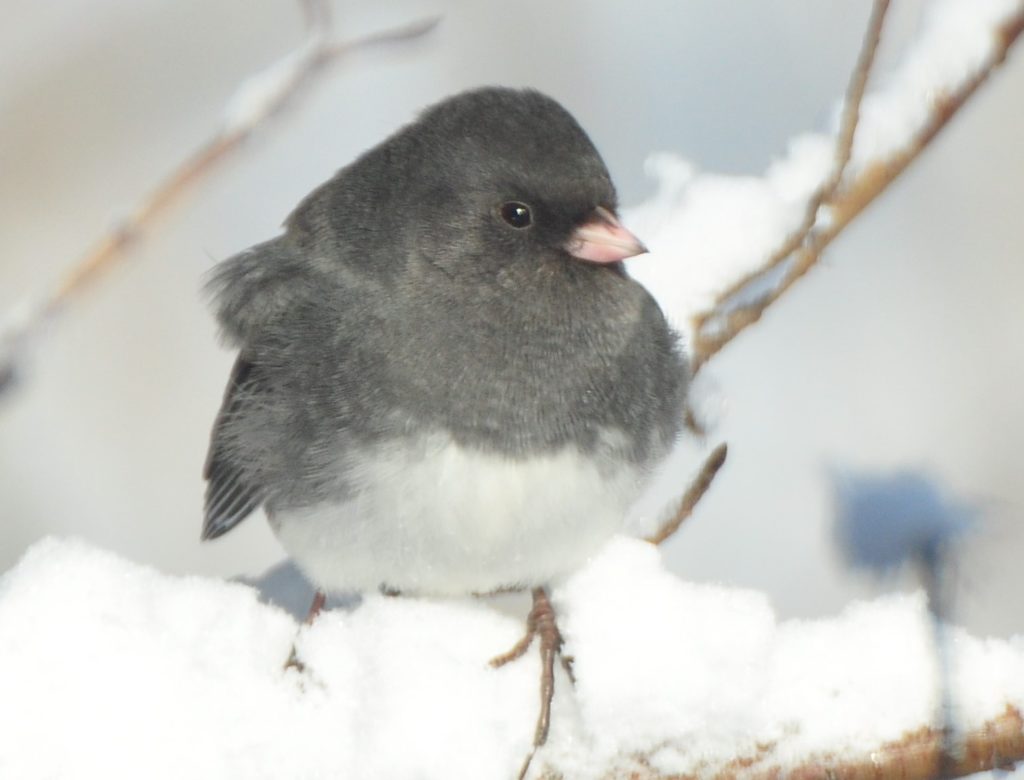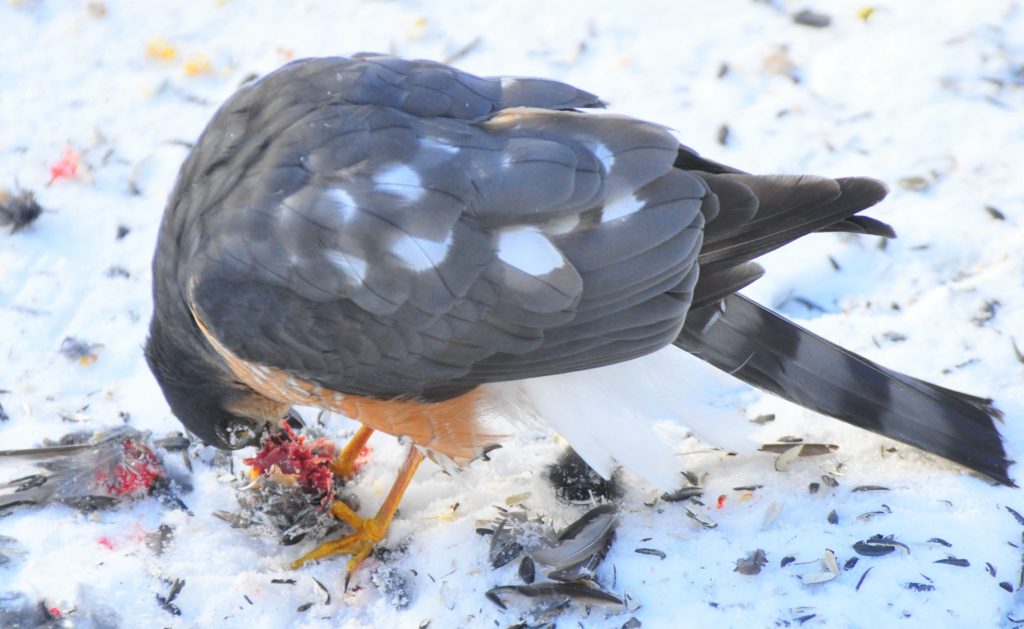Photography courtesy of Lowell Washburn, all rights reserved.
For those who abhor cold weather, backyard bird feeding is the perfect winter pastime. You get to enjoy the daily activities wild birdlife but, instead of braving the elements, you do it from the warmth of your living room — and without the cumbersome hassle of coats, boots, mittens and handwarmers.
Winter bird feeding is as simple, or as complicated, as you care to make it. The greater the variety of foods you provide, the greater the number of species and total birds you’ll attract. Watching as birds busily forage just beyond your window adds a sense of peaceful animation to an otherwise dormant landscape.

There are times, however, when serenity gives way to drama. A recent example occurred few days ago when my wife, Carol, called me to the dining room window; the urgency of her tone belying that something out of the ordinary was taking place. Although I had been watching the feeders just moments before, I took the bait and made a cautious, low profile approach to the windows. Peering over the sill, the backyard scene had indeed changed. Where there had been dozens of birds before, there were now only two – a junco and a sharp-shinned hawk. The junco was dead. The hawk was feeding.
The mid-February wind chill had plunged to a brutal 35 below. Cold enough that heat escaping from the raptor’s eyeballs was turning to frost before it could escape into the atmosphere. The hawk was in an obvious hurry, frantically casting feathers to the wind while intermittently consuming bits of exposed meat from its still steaming victim. This was serious business, and there was good reason for the sharp-shinned’s haste. The hawk had maybe four or five minutes tops, before its hot meal became a useless ball of frozen feathers.

The hawk was so intent on consuming its meal that I was able to quietly crack the window, sneak a camera lens into the gap, and shoot several photos before the junco was completely devoured. Filled and warmed, the sharp-shinned promptly left the scene. Within minutes, the yard was once again covered with foraging birdlife.
Dramatic and educational, the encounter had provided a rare opportunity to observe the predator/prey relationship in real time. Not everyone will share that perspective, of course. Over the years, I’ve received numerous calls – some bordering on hysteria – regarding hawks chasing birds at backyard feeders. In nearly all cases, the winged offenders were either the crow-sized Cooper’s hawk or its smaller cousin, the robin-sized sharp-shinned. Both species are lightning fast, woodland raptors who make a living by catching and eating other birds. Common prey items include sparrows, doves, juncos, blackbirds and starlings.
I have also received an occasional call when a larger raptor — like a big female red-tail — nailed a neighborhood squirrel. By contrast, no one ever cared about the fate of the squirrel. Instead, the questions would usually go something like, “Will my cat still be safe in the backyard?”
“Well, how big is your cat?” I would ask. It was an honest question but, at this point, the conversation was likely to go south. Some callers might even go so far as to slam the receiver in my ear.
While I’m at it, I will also admit to frequently flunking the quiz when asked what to do about “those mean hawks chasing my cute little birds.”
My answer was always the same. When the weather is cold and you put out sunflower seed, cracked corn, suet, and peanut butter, you’re going to attract a lot of birds. That’s called success. Though they occur in much smaller numbers than other birds, there are also hawks on virtually any given landscape. Sooner or later, a passing hawk – like the little sharp-shinned — may spot your concentration of birdlife and swoop in for a meal. That, at least in my opinion, is also success. It is simply taking backyard bird feeding to its next highest level. Disruption will be brief. As soon as the hawk moves on, normal activity will quickly resume.
Although completely factual, my answer was universally unacceptable. I’d love to share some of the comments my response generated, but I guess some things are better left unsaid.

 Tom Cope
Tom Cope Sue Wilkinson
Sue Wilkinson Susan Judkins Josten
Susan Judkins Josten Rudi Roeslein
Rudi Roeslein Elyssa McFarland
Elyssa McFarland Mark Langgin
Mark Langgin Adam Janke
Adam Janke Joe Henry
Joe Henry Kristin Ashenbrenner
Kristin Ashenbrenner Joe Wilkinson
Joe Wilkinson Dr. Tammy Mildenstein
Dr. Tammy Mildenstein Sean McMahon
Sean McMahon